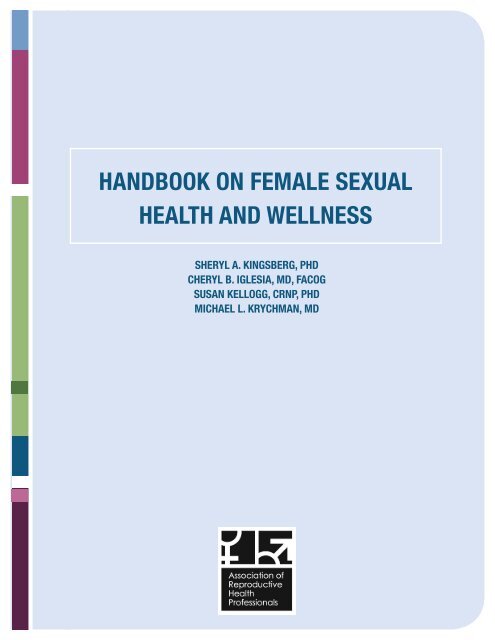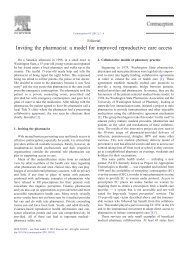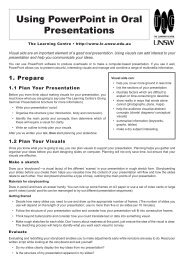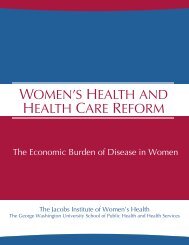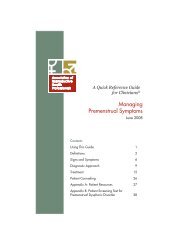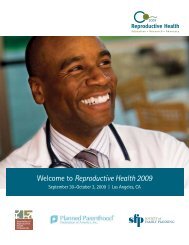handbook on female sexual health and wellness - Association of ...
handbook on female sexual health and wellness - Association of ...
handbook on female sexual health and wellness - Association of ...
You also want an ePaper? Increase the reach of your titles
YUMPU automatically turns print PDFs into web optimized ePapers that Google loves.
HANDBOOK ON FEMALE SEXUAL<br />
HEALTH AND WELLNESS<br />
SHERYL A. KINGSBERG, PHD<br />
CHERYL B. IGLESIA, MD, FACOG<br />
SUSAN KELLOGG, CRNP, PHD<br />
MICHAEL L. KRYCHMAN, MD
EXPERT ADVISORY COMMITTEE<br />
Sheryl A. Kingsberg, PhD (Chair)<br />
Clinical Psychologist <strong>and</strong> Pr<strong>of</strong>essor<br />
Department <strong>of</strong> Reproductive Biology<br />
Case Western Reserve University School <strong>of</strong> Medicine<br />
Chief, Divisi<strong>on</strong> <strong>of</strong> Behavioral Medicine<br />
Department <strong>of</strong> OB/GYN<br />
University Hospitals Case Medical Center<br />
Clevel<strong>and</strong>, OH<br />
Cheryl B. Iglesia, MD, FACOG<br />
Associate Pr<strong>of</strong>essor <strong>of</strong> Obstetrics, Gynecology <strong>and</strong> Urology<br />
Georgetown University School <strong>of</strong> Medicine<br />
Secti<strong>on</strong> Director<br />
Female Pelvic Medicine <strong>and</strong> Rec<strong>on</strong>structive Surgery<br />
Washingt<strong>on</strong> Hospital Center<br />
Washingt<strong>on</strong>, DC<br />
Susan Kellogg, CRNP, PhD<br />
Pr<strong>of</strong>essor <strong>of</strong> OB/GYN<br />
Drexel University College <strong>of</strong> Medicine<br />
Pr<strong>of</strong>essor <strong>of</strong> Human Sexuality<br />
Widener University<br />
Director, Sexual Medicine<br />
The Pelvic <strong>and</strong> Sexual Health Institute<br />
Philadelphia, Pennsylvania<br />
Michael L. Krychman, MD, FACOG<br />
Medical Director, Sexual Medicine Hoag<br />
Memorial Hospital Presbyterian<br />
Executive Director, Southern California Center<br />
for Sexual Health <strong>and</strong> Survivorship Medicine<br />
Associate Clinical Pr<strong>of</strong>essor<br />
University <strong>of</strong> Southern California<br />
Newport Beach, California<br />
Independent support for this publicati<strong>on</strong> provided to ARHP<br />
by Boehringer Ingelheim Pharmaceuticals, Inc.<br />
TABLE OF CONTENTS<br />
FORWARD: “WHY BOTHER?” 3<br />
CLINICAL COMPETENCIES: SCREENING<br />
AND STARTING THE CONVERSATION 4<br />
WHEN AND HOW TO REFER 7<br />
FEMALE SEXUAL DYSFUNCTIONS:<br />
DSM-IV-TR DEFINITIONS 8<br />
FEMALE SEXUAL RESPONSE 10<br />
ELEMENTS OF A COMPLETE SEXUAL HISTORY 12<br />
SCREENING FOR FEMALE SEXUAL<br />
DYSFUNCTION 14<br />
TREATING FEMALE SEXUAL DYSFUNCTION 16<br />
CLINICAL COMPETENCIES FOR SEXUAL HEALTH:<br />
TOP 10 THINGS YOU SHOULD KNOW 20<br />
EMERGING SEXUAL PHARMACOLOGY 21<br />
SEXUAL DYSFUNCTIONS RELATED TO<br />
COMMONLY SEEN OB/GYN CONDITIONS 22<br />
2
Many patients have c<strong>on</strong>cerns regarding <strong>sexual</strong> <strong>health</strong> <strong>and</strong> functi<strong>on</strong> <strong>and</strong> want to talk with you about these<br />
c<strong>on</strong>cerns. And, they want you to raise the subject first. In a 2009 nati<strong>on</strong>al survey, over 80% <strong>of</strong> women<br />
polled believed that <strong>sexual</strong> <strong>health</strong> was an important part <strong>of</strong> overall <strong>health</strong>. Another survey found that the<br />
majority <strong>of</strong> women (72%) wanted to speak with their <strong>health</strong> care pr<strong>of</strong>essi<strong>on</strong>al about their <strong>sexual</strong> <strong>health</strong>,<br />
<strong>and</strong> 73% preferred that the <strong>health</strong> care pr<strong>of</strong>essi<strong>on</strong>al bring up the topic.<br />
Addressing <strong>sexual</strong> <strong>health</strong> issues with our patients has enhanced our practices <strong>and</strong> improved the well-being<br />
<strong>of</strong> our patients. We have found that many <strong>sexual</strong> <strong>health</strong> issues are easy to assess in a quick fashi<strong>on</strong>, <strong>and</strong><br />
do not adversely impact patient flow. Simple interventi<strong>on</strong>s <strong>of</strong>ten lead to more successful outcomes.<br />
This <str<strong>on</strong>g>h<strong>and</strong>book</str<strong>on</strong>g> <strong>of</strong>fers fr<strong>on</strong>t-line <strong>health</strong>care pr<strong>of</strong>essi<strong>on</strong>als the practical <strong>and</strong> clinical tools needed for the<br />
care <strong>of</strong> women with <strong>sexual</strong> c<strong>on</strong>cerns, including definiti<strong>on</strong>s <strong>and</strong> informati<strong>on</strong> about screening, diagnosis,<br />
<strong>and</strong> treatment. We hope the recommendati<strong>on</strong>s made in this easy-to-use <str<strong>on</strong>g>h<strong>and</strong>book</str<strong>on</strong>g> provide you with the<br />
essential skills <strong>and</strong> resources to effectively begin the discussi<strong>on</strong> about <strong>sexual</strong>ity with your <strong>female</strong> patients,<br />
assess <strong>and</strong> manage comm<strong>on</strong> <strong>sexual</strong> <strong>health</strong> <strong>and</strong> <strong>wellness</strong> issues, <strong>and</strong> provide you with guidance <strong>on</strong> making<br />
appropriate referrals.<br />
FORWARD: “WHY BOTHER?”<br />
Sheryl A. Kingsberg, PhD<br />
Cheryl B. Iglesia, MD, FACOG<br />
Susan Kellogg, CRNP, PhD<br />
Michael L. Krychman, MD<br />
3
Patients want to talk to you about their <strong>sexual</strong> c<strong>on</strong>cerns—<strong>and</strong> they want you<br />
to raise the subject first. So how do you start the c<strong>on</strong>versati<strong>on</strong>?<br />
The PLISSIT model can be a helpful tool for discussing <strong>sexual</strong> <strong>health</strong> or c<strong>on</strong>cerns with patients.<br />
The model provides the following guidance:<br />
n Ask open-ended questi<strong>on</strong>s during routine history to give the patient permissi<strong>on</strong> to talk about<br />
her <strong>sexual</strong> c<strong>on</strong>cerns <strong>and</strong> reassure her that her feelings are normal <strong>and</strong> acceptable (see figure)<br />
Example: “Many women with menopause have <strong>sexual</strong> c<strong>on</strong>cerns. Do you?”<br />
n Follow-up questi<strong>on</strong>s: “What do you mean by that?” “Tell me more.”<br />
n Provide limited informati<strong>on</strong><br />
— Educati<strong>on</strong> about <strong>female</strong> pelvic anatomy, the <strong>sexual</strong> resp<strong>on</strong>se cycle, or the neurobiologic<br />
etiology <strong>of</strong> <strong>sexual</strong> problems<br />
— Discuss changes in <strong>sexual</strong> functi<strong>on</strong> throughout the lifecycle<br />
— Explain that <strong>sexual</strong> interest or desire may not be the first stage in resp<strong>on</strong>se, <strong>and</strong><br />
women may not experience orgasm 100% <strong>of</strong> the time<br />
n Address the most important topics that you can in the limited time you have available;<br />
do not feel pressured to cover it all in <strong>on</strong>e visit<br />
n Encourage a follow-up appointment to focus solely <strong>on</strong> <strong>sexual</strong> <strong>health</strong> c<strong>on</strong>cerns<br />
n Offer specific suggesti<strong>on</strong>s <strong>and</strong> soluti<strong>on</strong>s to treat the problem<br />
Examples: Use lubricant, over-the-counter moisturizers, or topical estrogen for dryness/<br />
dyspareunia; plan date nights <strong>and</strong> make <strong>sexual</strong> behavior a priority; improve diet, exercise,<br />
<strong>and</strong> sleep patterns to help overall mood<br />
Bey<strong>on</strong>d providing basic informati<strong>on</strong> <strong>and</strong> suggesti<strong>on</strong>s, many primary care providers will want<br />
to refer a patient, possibly for intensive therapy, to qualified <strong>sexual</strong>ity specialists (see box).<br />
When c<strong>on</strong>ducting an interview, the PEARLS model can provide a useful structure to elicit<br />
empathy <strong>and</strong> open communicati<strong>on</strong>:<br />
— Partnership: acknowledges that the <strong>health</strong> care pr<strong>of</strong>essi<strong>on</strong>al <strong>and</strong> the patient are in<br />
this together<br />
— Empathy: expresses underst<strong>and</strong>ing to the patient<br />
— Apology: acknowledge that the <strong>health</strong> care pr<strong>of</strong>essi<strong>on</strong>al is sorry the patient had to wait,<br />
that a laboratory test had to be repeated, etc.<br />
— Respect/Reflect/Reinforce: acknowledge the patient’s suffering, difficulties, etc.<br />
— Legitimize: acknowledge that many patients are angry, frustrated, depressed, etc.<br />
— Support: acknowledge that the <strong>health</strong> care pr<strong>of</strong>essi<strong>on</strong>al will not ab<strong>and</strong><strong>on</strong> the patient<br />
The following basic clinical competencies can help any women’s <strong>health</strong> care practice integrate<br />
c<strong>on</strong>versati<strong>on</strong>s about <strong>sexual</strong> c<strong>on</strong>cerns into routine patient visits:<br />
n Initiate a frank c<strong>on</strong>cise c<strong>on</strong>versati<strong>on</strong> about <strong>sexual</strong> <strong>health</strong> in an appropriate <strong>health</strong><br />
care envir<strong>on</strong>ment<br />
n Complete an appropriate <strong>sexual</strong> <strong>health</strong> history, appropriate to the c<strong>on</strong>cern<br />
n Bring closure to a current appointment <strong>and</strong> segue to a subsequent appointment if needed<br />
n When appropriate, recommend <strong>and</strong> refer to a qualified specialist best suited to address<br />
the patient’s <strong>sexual</strong> c<strong>on</strong>cern (see page 13)<br />
STARTING THE CONVERSATION<br />
PLISSIT MODEL<br />
Permissi<strong>on</strong><br />
Limited<br />
Informati<strong>on</strong><br />
Specific<br />
Suggesti<strong>on</strong>s<br />
Intensive<br />
Therapy<br />
PEARLS MODEL<br />
Partnership<br />
Empathy<br />
Apology<br />
Respect/<br />
Reflect/Reinforse<br />
Legitamize<br />
Support<br />
4
PSYCHOSOCIAL ISSUES<br />
Sexual functi<strong>on</strong> does not exist<br />
in a vacuum—it is influenced by<br />
relati<strong>on</strong>ships, fatigue, stress, <strong>and</strong><br />
other sociocultural factors in a<br />
woman’s life. The following issues<br />
are important to assess to provide<br />
the appropriate c<strong>on</strong>text for your<br />
clinical evaluati<strong>on</strong>:<br />
n Sexuality <strong>and</strong> desire can be deeply affected<br />
by the <strong>health</strong>, stability, <strong>and</strong> status <strong>of</strong> the<br />
woman’s relati<strong>on</strong>ship<br />
n There is an important difference between<br />
<strong>sexual</strong> drive (primarily the biological<br />
comp<strong>on</strong>ent <strong>of</strong> desire) <strong>and</strong> <strong>sexual</strong><br />
motivati<strong>on</strong> (primarily the intrapsychic<br />
<strong>and</strong> interpers<strong>on</strong>al comp<strong>on</strong>ents)<br />
n Current <strong>and</strong> past abuse can impact <strong>sexual</strong><br />
<strong>health</strong>; ask about a history <strong>of</strong> <strong>sexual</strong> abuse<br />
in routine <strong>health</strong> care examinati<strong>on</strong>s with<br />
clear, direct questi<strong>on</strong>s (e.g., “Has any<strong>on</strong>e,<br />
including your partner or a family member,<br />
ever forced you to do something <strong>sexual</strong>ly<br />
that you did not want to do?”)<br />
n Cultural <strong>and</strong> religious backgrounds can<br />
influence <strong>sexual</strong> <strong>health</strong>; therefore, without<br />
judgement, ask about the patient’s values,<br />
beliefs, <strong>and</strong> desires regarding <strong>sexual</strong>ity <strong>and</strong><br />
<strong>sexual</strong> activity within her relati<strong>on</strong>ship(s)<br />
n A partner’s <strong>sexual</strong> dysfuncti<strong>on</strong> can affect<br />
your patient’s <strong>sexual</strong> <strong>health</strong> <strong>and</strong> satisfacti<strong>on</strong>;<br />
be sure to ask about the <strong>health</strong> <strong>and</strong><br />
well-being <strong>of</strong> the patient’s partner(s) as well<br />
SEXUAL DRIVE VS.<br />
n Based <strong>on</strong> neuroendocrine mechanisms <strong>and</strong><br />
evidenced by sp<strong>on</strong>taneous <strong>sexual</strong> interest<br />
n Relative, <strong>and</strong> each pers<strong>on</strong> has a certain drive level<br />
n Exact neuroendocrine mechanisms resp<strong>on</strong>sible<br />
for drive remain unclear<br />
n In some, <strong>sexual</strong> drive declines progressively<br />
as a functi<strong>on</strong> <strong>of</strong> aging<br />
BASIC SCREENING FOR SEXUAL FUNCTION<br />
LEGITIMIZE THE IMPORTANCE OF<br />
ASSESSING SEXUAL FUNCTION<br />
“It is part <strong>of</strong> my routine to ask about<br />
<strong>sexual</strong> <strong>health</strong> as part <strong>of</strong> the well-woman visit.<br />
Do you have any c<strong>on</strong>cerns?”<br />
“Some studies show that as women age,<br />
they may have less desire for sex<br />
or decreased lubricati<strong>on</strong>,which makes<br />
intercourse uncomfortable.”<br />
“Have you noticed any changes?”<br />
“ARE YOU CURRENTLY INVOLVED IN<br />
A SEXUAL RELATIONSHIP?”<br />
Yes<br />
“With men,<br />
women, or both?”<br />
“Any <strong>sexual</strong> c<strong>on</strong>cerns<br />
or pain with sex?”<br />
SEXUAL MOTIVATION<br />
No<br />
“Any <strong>sexual</strong><br />
c<strong>on</strong>cerns you would<br />
like to discuss or<br />
that have c<strong>on</strong>tributed<br />
to lack <strong>of</strong> <strong>sexual</strong><br />
behavior?”<br />
n Characterized by the willingness <strong>of</strong> a pers<strong>on</strong> to engage<br />
in <strong>sexual</strong> activity<br />
n Often the most important comp<strong>on</strong>ent <strong>of</strong> <strong>sexual</strong> desire<br />
n Can be impacted by the quality <strong>of</strong> a relati<strong>on</strong>ship,<br />
psychologic functi<strong>on</strong>ing, worries about <strong>health</strong>, children<br />
n A pers<strong>on</strong> can have high levels <strong>of</strong> <strong>sexual</strong> desire but if they<br />
have c<strong>on</strong>flict with their partner or are suffering from clinical<br />
depressi<strong>on</strong>, motivati<strong>on</strong> to be <strong>sexual</strong> will <strong>of</strong>ten be lacking<br />
5
OPEN-ENDED “ICEBREAKERS” TO START THE DISCUSSION<br />
The following phrases can open a dialogue about <strong>sexual</strong> <strong>health</strong> with your patients. When<br />
you talk about this issue within the overall history will vary. Many <strong>health</strong> pr<strong>of</strong>essi<strong>on</strong>als use<br />
them in the social history or review <strong>of</strong> systems. They are also helpful in assessing the pers<strong>on</strong>al,<br />
relati<strong>on</strong>ship, <strong>and</strong> global impact <strong>of</strong> <strong>sexual</strong> c<strong>on</strong>cerns.<br />
n It is part <strong>of</strong> my routine to ask about <strong>sexual</strong> <strong>health</strong> as part <strong>of</strong> the well-woman visit. Tell me about any <strong>sexual</strong><br />
c<strong>on</strong>cern/problem/issue you may be having.<br />
n How do you think this <strong>sexual</strong> problem may be affecting your relati<strong>on</strong>ship or your life in general?<br />
n Please describe your <strong>sexual</strong> problem.<br />
n What distresses you the most about this <strong>sexual</strong> problem?<br />
n What have you tried to manage the problem so far?<br />
n Do you have any medical c<strong>on</strong>diti<strong>on</strong>s that affect your quality <strong>of</strong> life, including your <strong>sexual</strong> <strong>health</strong>?<br />
n What would a successful resoluti<strong>on</strong> <strong>of</strong> your <strong>sexual</strong> problem(s) look like?<br />
n Tell me about the c<strong>on</strong>versati<strong>on</strong>s you have had with your partner so far about this problem.<br />
You may also want to c<strong>on</strong>sider asking close-ended questi<strong>on</strong>s which require a direct answer (i.e., Does sex hurt? Are<br />
you <strong>sexual</strong>ly satisfied?). Follow-up these close-ended questi<strong>on</strong>s with another open-ended comment to allow further<br />
expansi<strong>on</strong> <strong>of</strong> the problem (i.e., Tell me more. What do you mean by that?). Encourage the woman to use her own<br />
language with which she is most comfortable. If you are unfamiliar with her terms, do not be afraid to ask for clarificati<strong>on</strong>.<br />
FEMALE SEXUALITY PATIENT HANDOUTS<br />
There are a number <strong>of</strong> sources for obtaining patient h<strong>and</strong>outs <strong>on</strong> <strong>female</strong> <strong>sexual</strong>ity. They<br />
are best utilized as adjuncts to patient/clinician discussi<strong>on</strong>, not as an alternative to them.<br />
n American Associati<strong>on</strong> <strong>of</strong> Sexuality Educators Counselors <strong>and</strong> Therapists (www.aasect.org)<br />
n American College <strong>of</strong> Obstetricians <strong>and</strong> Gynecologists (www.acog.org/publicati<strong>on</strong>s/patient_educati<strong>on</strong>/)<br />
n ARHP Sex <strong>and</strong> Sexuality Reproductive Health Topic Area (www.arhp.org/Topics/Sex-<strong>and</strong>-Sexuality)<br />
n Internati<strong>on</strong>al Society for the Study <strong>of</strong> Women’s Sexual Health (www.isswsh.org)<br />
n Healthy Women (http://www.<strong>health</strong>ywomen.org/publicati<strong>on</strong>s)<br />
n North American Menopause Society (www.menopause.org/edumaterials.aspx)<br />
6
Most fr<strong>on</strong>t-line heath care pr<strong>of</strong>essi<strong>on</strong>als are comfortable managing <strong>sexual</strong> issues—up to a point.<br />
Most practices can do the following:<br />
n Give the patient permissi<strong>on</strong> to discuss the problem<br />
n Validate her c<strong>on</strong>cern as legitimate<br />
n Provide limited informati<strong>on</strong> <strong>and</strong> suggesti<strong>on</strong>s<br />
n Determine if a follow-up visit is required<br />
When a <strong>sexual</strong> c<strong>on</strong>cern exceeds your level <strong>of</strong> comfort or expertise or warrants intensive therapy, you will want to refer a patient to<br />
a qualified specialist, such as a sex therapist (see box). Comprehensive <strong>and</strong> optimal <strong>sexual</strong> care <strong>of</strong>ten may require both a physical<br />
<strong>and</strong> mental <strong>health</strong> approach <strong>and</strong> a multidisciplinary team is <strong>of</strong>ten crucial. It can help to:<br />
n Become familiar with certified sex therapists <strong>and</strong> <strong>sexual</strong>ity counselors in your area<br />
n Refer the patient with the assurance that you are adding a team member to address her problem <strong>and</strong> emphasize<br />
that you will c<strong>on</strong>tinue <strong>on</strong>going involvement in her care<br />
SEX THERAPY RESOURCES<br />
WHEN AND HOW TO REFER<br />
n American Associati<strong>on</strong> <strong>of</strong> Sexuality Educators Counselors <strong>and</strong> Therapists (www.aasect.org)<br />
n Internati<strong>on</strong>al Society for the Study <strong>of</strong> Women’s Sexual Health (www.isswsh.org)<br />
n Society for Sex Therapy <strong>and</strong> Research (www.sstarnet.org)<br />
7
The DSM IV TR criteria for <strong>female</strong> <strong>sexual</strong> dysfuncti<strong>on</strong>:<br />
n Classified as persistent or recurrent <strong>and</strong> causing “marked distress” or “interpers<strong>on</strong>al difficulty”<br />
n Not better accounted for by a general medical or psychiatric c<strong>on</strong>diti<strong>on</strong> (i.e., anxiety <strong>and</strong> depressi<strong>on</strong>)<br />
n Not due exclusively to the direct physiologic effects <strong>of</strong> a substance or medicati<strong>on</strong><br />
n Sexual Dysfuncti<strong>on</strong> may be:<br />
— Lifel<strong>on</strong>g: has been present since the <strong>on</strong>set <strong>of</strong> <strong>sexual</strong> functi<strong>on</strong>ing<br />
— Acquired: develops <strong>on</strong>ly after a period <strong>of</strong> normal functi<strong>on</strong>ing<br />
— Situati<strong>on</strong>al: is limited to certain types <strong>of</strong> stimulati<strong>on</strong>, situati<strong>on</strong>s, or partners<br />
— Generalized: is not limited to certain types <strong>of</strong> stimulati<strong>on</strong>, situati<strong>on</strong>s, or partners<br />
Sexual desire disorders<br />
Hypoactive <strong>sexual</strong> desire disorder<br />
FEMALE SEXUAL DYSFUNCTIONS: DSM-IV-TR DEFINITIONS<br />
DSM-IV<br />
or ICD-9<br />
302.71 or<br />
799.81<br />
Sexual aversi<strong>on</strong> disorder 302.79<br />
Sexual arousal disorders<br />
Female <strong>sexual</strong> arousal disorder 302.72<br />
Orgasmic disorders<br />
Female orgasmic disorder 302.73<br />
Sexual pain disorders<br />
Dyspareunia<br />
Vaginismus<br />
FEMALE SEXUAL DYSFUNCTIONS: DSM-IV-TR DEFINITIONS<br />
302.76 or<br />
625.0<br />
306.51 or<br />
625.1 or<br />
DSM-IV Definiti<strong>on</strong>s<br />
Deficiency or absence <strong>of</strong> <strong>sexual</strong> fantasies <strong>and</strong> desire for <strong>sexual</strong><br />
activity<br />
Aversi<strong>on</strong> to <strong>and</strong> active avoidance <strong>of</strong> genital <strong>sexual</strong> c<strong>on</strong>tact with<br />
a <strong>sexual</strong> partner<br />
Persistent or recurrent inability to attain, or to maintain until<br />
completi<strong>on</strong> <strong>of</strong> the <strong>sexual</strong> activity, an adequate lubricati<strong>on</strong>-swelling<br />
resp<strong>on</strong>se or <strong>sexual</strong> excitement<br />
Persistent or recurrent delay in, or absence <strong>of</strong>, orgasm following a<br />
normal <strong>sexual</strong> excitement<br />
Genital pain that is associated with <strong>sexual</strong> intercourse<br />
Recurrent or persistent involuntary c<strong>on</strong>tracti<strong>on</strong> <strong>of</strong> the perineal<br />
muscles surrounding the outer third <strong>of</strong> the vagina when vaginal<br />
penetrati<strong>on</strong> with penis, finger, tamp<strong>on</strong>, or speculum is attempted<br />
American Psychiatric Associati<strong>on</strong>. Diagnostic <strong>and</strong> Statistical Manual <strong>of</strong> Mental Disorders. Fourth Editi<strong>on</strong>. Text Revisi<strong>on</strong>.<br />
Washingt<strong>on</strong>, DC; American Psychiatric Associati<strong>on</strong>; 2000.<br />
Buck CJ, et al. 2009 ICD-9-CM Pr<strong>of</strong>essi<strong>on</strong>al Editi<strong>on</strong>, Volumes 1 & 2. St. Louis, MO; Saunders Elsevier; 2008.<br />
8
CLINICAL PEARLS<br />
n Overlapping <strong>sexual</strong> disorders are very comm<strong>on</strong> (e.g., hypoactive <strong>sexual</strong> desire disorder <strong>of</strong>ten results in decreased<br />
arousal <strong>and</strong> difficulty with orgasm)<br />
— When <strong>on</strong>e dysfuncti<strong>on</strong> is revealed, ask about others<br />
— Treatment <strong>of</strong> disorders may be c<strong>on</strong>current or sequential<br />
n Discuss the chr<strong>on</strong>ology <strong>of</strong> the <strong>sexual</strong> c<strong>on</strong>cerns; it is imperative to uncover which <strong>sexual</strong> problem presented first<br />
n The key is to define the primary disorder <strong>and</strong> discuss with the patient which disorder should be addressed first<br />
9
AROUSAL AND<br />
SEXUAL DESIRE<br />
Bass<strong>on</strong> R. Med Aspects Hum Sex. 2001;1:41-42<br />
ORGASM<br />
PLATEAU<br />
BIOLOGY<br />
(e.g., physical <strong>health</strong>,<br />
neurobiology,<br />
endocrine functi<strong>on</strong>)<br />
SOCIOCULTURAL INTERPERSONAL<br />
(eg, upbringing, cultural<br />
norms <strong>and</strong> expectati<strong>on</strong>s)<br />
EMOTIONAL AND<br />
PHYSICAL EXCITEMENT SATISFACTION<br />
BIOLOGY<br />
(e.g., physical <strong>health</strong>,<br />
neurobiology,<br />
endocrine functi<strong>on</strong>)<br />
EMOTIONAL INTIMACY<br />
SPONTANEOUS<br />
RESOLUTION<br />
SEXUAL DRIVE<br />
FEMALE SEXUAL RESPONSE<br />
SEXUAL STIMULI<br />
RESOLUTION<br />
TIME<br />
AROUSAL AND<br />
SEXUAL DESIRE<br />
Adapted from Masters WH, SEXUAL Johns<strong>on</strong> AROUSAL VE. Human Sexual Inadequacy . Little Brown; 1970. BIOLOGIC<br />
Bass<strong>on</strong> R. Med Aspects Hum Sex. 2001;1:41-42<br />
SEXUAL AROUSAL<br />
CIRCULAR MODEL<br />
PSYCHOLOGICAL<br />
PSYCHOLOGY<br />
(eg, performance<br />
anxiety, depressi<strong>on</strong>)<br />
(eg., quality <strong>of</strong> current <strong>and</strong> past<br />
relati<strong>on</strong>ships,intervals <strong>of</strong><br />
abstinence,life stressors, finances)<br />
PSYCHOLOGY<br />
(eg, performance<br />
anxiety, depressi<strong>on</strong>)<br />
BIOLOGIC<br />
There are a variety <strong>of</strong> opini<strong>on</strong>s, definiti<strong>on</strong>s, <strong>and</strong> theoretical models that describe normal <strong>female</strong> <strong>sexual</strong> resp<strong>on</strong>se. For example,<br />
the DSM-IV-TR 2000 describes the <strong>sexual</strong> resp<strong>on</strong>se cycle as comprising desire, excitement, orgasm, <strong>and</strong> resoluti<strong>on</strong>. The<br />
following additi<strong>on</strong>al theoretical models may be useful to your underst<strong>and</strong>ing <strong>of</strong> the <strong>female</strong> <strong>sexual</strong> resp<strong>on</strong>se:<br />
BIOPSYCHOSOCIAL MODEL<br />
Seeking Out<br />
<strong>and</strong> Being<br />
RESOLUTION Receptive to<br />
PSYCHOLOGICAL<br />
BIOPSYCHOSOCIAL MODEL<br />
n Integrates multiple etiologic factors <strong>and</strong> determinants<br />
— Biologic (e.g., physical <strong>health</strong>, neurobiology, <strong>and</strong><br />
endocrine functi<strong>on</strong>)<br />
— Psychologic (e.g., performance anxiety <strong>and</strong> depressi<strong>on</strong>)<br />
— Sociocultural (e.g., upbringing, cultural norms, <strong>and</strong><br />
expectati<strong>on</strong>s)<br />
— Interpers<strong>on</strong>al (e.g., quality <strong>of</strong> current <strong>and</strong> past relati<strong>on</strong>ships,<br />
intervals <strong>of</strong> abstinence, life stressors, <strong>and</strong> finances)<br />
n The integrati<strong>on</strong> <strong>and</strong> input <strong>of</strong> all these comp<strong>on</strong>ents are<br />
essential for <strong>sexual</strong> resp<strong>on</strong>se<br />
CIRCULAR MODEL<br />
BEHAVIOR<br />
MODIFICATION<br />
ALTERNATIVE<br />
MEDICINE<br />
(Bass<strong>on</strong>) SEXUAL<br />
DEVICE<br />
n Sexual satisfacti<strong>on</strong>, <strong>and</strong> not orgasm, appears to be the<br />
focus in some women<br />
— A woman begins a <strong>sexual</strong> resp<strong>on</strong>se<br />
TREATMENT<br />
experience from<br />
a point <strong>of</strong> relative SEXUAL <strong>sexual</strong> neutrality but with a goal <strong>of</strong><br />
emoti<strong>on</strong>al PHARMACOLOGY intimacy with her partner; she may seek or be<br />
receptive to <strong>sexual</strong> stimuli<br />
— Goals for <strong>sexual</strong> activity may be complex <strong>and</strong> not<br />
CONSULTATIONS PSYCHOTHERAPY PAIN<br />
merely for internal satisfacti<strong>on</strong> <strong>of</strong> an “innate” MANAGEMENT<br />
<strong>sexual</strong> hunger<br />
— Receptivity to <strong>sexual</strong> stimuli allows the woman to<br />
move to a state <strong>of</strong> physiologic arousal<br />
— If the mind c<strong>on</strong>tinues to process the stimuli <strong>on</strong> to<br />
further arousal, <strong>sexual</strong> desire may encourage the<br />
woman to move forward to <strong>sexual</strong> satisfacti<strong>on</strong> <strong>and</strong><br />
orgasm fostering intimacy <strong>and</strong> reinforcing <strong>sexual</strong><br />
motivati<strong>on</strong><br />
— This model reinforces the noti<strong>on</strong> that <strong>female</strong> motivati<strong>on</strong><br />
for <strong>sexual</strong> activity is complex <strong>and</strong> not specifically an<br />
innate phenomen<strong>on</strong><br />
STRUCTURED<br />
SEXUAL<br />
TASKS<br />
TEST<br />
SYSTEMI<br />
ILLNESSE<br />
EVALUAT<br />
MEDICATIO<br />
PATIENT<br />
PARTNER<br />
EDUCATIO<br />
10
SOCIOCULTURAL INTERPERSONAL<br />
(eg, upbringing, cultural<br />
norms <strong>and</strong> expectati<strong>on</strong>s)<br />
ORGASM<br />
PLATEAU<br />
EXCITEMENT<br />
LINEAR MODEL<br />
RESOLUTION<br />
TIME<br />
(eg., quality <strong>of</strong> current <strong>and</strong> past<br />
relati<strong>on</strong>ships,intervals <strong>of</strong><br />
abstinence,life stressors, finances)<br />
RESOLUTION<br />
RESOLUTION<br />
Adapted from Masters WH, Johns<strong>on</strong> VE. Human Sexual Inadequacy . Little Brown; 1970.<br />
LINEAR MODEL<br />
BEHAVIOR ALTERNATIVE<br />
MODIFICATION<br />
(Masters <strong>and</strong> Johns<strong>on</strong>: traditi<strong>on</strong>al model MEDICINE <strong>of</strong><br />
a linear progressi<strong>on</strong> from <strong>on</strong>e phase <strong>of</strong> the<br />
<strong>sexual</strong> resp<strong>on</strong>se to the next)<br />
SEXUAL<br />
DEVICE<br />
n Views sex as a natural, biologic phenomen<strong>on</strong><br />
— Sensory stimulati<strong>on</strong> leads to increased<br />
peripheral blood flow <strong>and</strong> vasoc<strong>on</strong>gesti<strong>on</strong> TREATMENT<br />
— With c<strong>on</strong>tinuing SEXUAL stimulati<strong>on</strong>, increased pelvic<br />
PHARMACOLOGY<br />
floor muscle tensi<strong>on</strong> <strong>and</strong> vasoc<strong>on</strong>gesti<strong>on</strong> increase<br />
until development <strong>of</strong> a “plateau” phase that<br />
leads to orgasm; physical changes are apparent<br />
in the woman CONSULTATIONS PSYCHOTHERAPY PAIN<br />
MANAGEMENT<br />
— During orgasm, there is a brain discharge,<br />
widespread genitor-pelvic muscle c<strong>on</strong>tracti<strong>on</strong>,<br />
<strong>and</strong> increased cardiac output<br />
— Resoluti<strong>on</strong> follows orgasm with return to the<br />
n<strong>on</strong>-stimulated state.<br />
n The essential comp<strong>on</strong>ents <strong>of</strong> <strong>sexual</strong> resp<strong>on</strong>se depend<br />
up<strong>on</strong> adequate functi<strong>on</strong>ing <strong>and</strong> interplay <strong>of</strong> horm<strong>on</strong>al<br />
milieux, nerves, veins, arteries, <strong>and</strong> genitor-pelvic muscles<br />
STRUCTURED<br />
SEXUAL<br />
TASKS<br />
TEST<br />
SYSTEM<br />
ILLNESS<br />
EVALUA<br />
MEDICAT<br />
PATIENT<br />
PARTNE<br />
EDUCAT<br />
11
Sexual functi<strong>on</strong>ing is multifactorial. Factors associated with <strong>female</strong> <strong>sexual</strong> dysfuncti<strong>on</strong> include<br />
medicati<strong>on</strong>s, psychologic disorders, comorbidities, relati<strong>on</strong>ship/partnership issues, <strong>and</strong> horm<strong>on</strong>e<br />
use <strong>and</strong> n<strong>on</strong>-use.<br />
A thorough <strong>sexual</strong> history should assess medical, reproductive (obstetric/gynecologic), surgical, psychiatric, social, <strong>and</strong><br />
<strong>sexual</strong> informati<strong>on</strong>.<br />
n DSM-IV-TR: <strong>sexual</strong> dysfuncti<strong>on</strong> that is not better accounted for by a general medical or psychiatric c<strong>on</strong>diti<strong>on</strong>, nor due<br />
exclusively to the direct physiologic effects <strong>of</strong> a substance or medicati<strong>on</strong>.<br />
A patient’s history may not be sufficient to assess her <strong>sexual</strong> functi<strong>on</strong>, <strong>and</strong> a physical examinati<strong>on</strong> or laboratory testing may be needed to<br />
determine if anatomic or physiologic factors are involved in a <strong>sexual</strong> complaint (The American College <strong>of</strong> Obstetricians <strong>and</strong> Gynecologists<br />
note that local practices <strong>and</strong> expectati<strong>on</strong>s can differ regarding the use <strong>of</strong> chaper<strong>on</strong>es, <strong>and</strong> recommend that the request by either a patient<br />
or physician to have a chaper<strong>on</strong>e present during a physical examinati<strong>on</strong> should be accommodated, regardless <strong>of</strong> the physician’s sex.<br />
— ACOG Guidelines for Women’s Health Care, 3rd editi<strong>on</strong> 2007).<br />
ELEMENTS OF A THOROUGH SEXUAL HISTORY<br />
Because a variety <strong>of</strong> general <strong>health</strong> <strong>and</strong> psychosocial factors can impact <strong>sexual</strong> functi<strong>on</strong>, a thorough <strong>sexual</strong> history must<br />
cover a lot <strong>of</strong> ground:<br />
Psychosocial Issues<br />
n Relati<strong>on</strong>ship status<br />
n History <strong>of</strong> abuse (verbal, emoti<strong>on</strong>al, physical, or <strong>sexual</strong>)<br />
n Alcohol, tobacco, illicit drug use<br />
Medical Issues<br />
n Current <strong>health</strong> status<br />
n Past medical history<br />
n Medicati<strong>on</strong>s<br />
n Reproductive history <strong>and</strong> current status<br />
— Age <strong>of</strong> menarche<br />
— Menstrual history<br />
— Obstetric history (pregnancies, losses, durati<strong>on</strong> <strong>of</strong><br />
labor, <strong>and</strong> c<strong>on</strong>sequences <strong>of</strong> delivery, delivery type,<br />
birthweights)<br />
— Infertility<br />
— C<strong>on</strong>tracepti<strong>on</strong><br />
— Sexually transmitted infecti<strong>on</strong>s<br />
— Gynecologic problems (pain, pelvic floor disorders,<br />
postpartum)<br />
— Surgeries<br />
— Urologic problems (inc<strong>on</strong>tinence episodes)<br />
ELEMENTS OF A COMPLETE SEXUAL HISTORY<br />
n Surgical history<br />
n Endocrine system<br />
— Diabetes<br />
— Thyroid disorders<br />
— Hyperprolactinemia<br />
— Androgen deficiency<br />
n Neurologic disorders<br />
n Hypertensi<strong>on</strong><br />
n Psychiatric illnesses<br />
— Mood disorders (major depressi<strong>on</strong>, bipolar illness)<br />
— Anxiety disorders<br />
— Psychotic illness<br />
n Other chr<strong>on</strong>ic illnesses<br />
— Breast cancer<br />
— Rheumatoid arthritis<br />
— Psoriasis<br />
12
GYNECOLOGIC EXAMINATION:<br />
If the history indicates that a physical examinati<strong>on</strong> is necessary, it should include the elements<br />
outlined in the table below.<br />
Adapted from Phillips NA. The clinical evaluati<strong>on</strong> <strong>of</strong> dyspareunia. Int J Impot Res. 1998;(suppl 2):S117-S120.<br />
COMMON MEDICATIONS THAT MAY IMPACT FEMALE SEXUAL FUNCTION<br />
n Antidepressants <strong>and</strong> mood stabilizers<br />
— Tricyclic antidepressants<br />
— MAOIs (m<strong>on</strong>oamine oxidase inhibitors)<br />
— SSRIs (selective serot<strong>on</strong>in-uptake inhibitors)<br />
— SNRIs (serot<strong>on</strong>in-norepinephrine reuptake inhibitors)<br />
— Typical antipsychotics (phenothiazines,<br />
thioxanthenes, butyrophen<strong>on</strong>es)<br />
— Atypical antipsychotics<br />
— Mood stabilizers (e.g., carbamazepine, lithium)<br />
n Other CNS drugs<br />
— Antic<strong>on</strong>vulsants (e.g., phenobarbital, phenytoin)<br />
— Anticholinergics (e.g., diphenhydramine, benztropine)<br />
— Opioids<br />
— Amphetamines<br />
n Horm<strong>on</strong>es <strong>and</strong> horm<strong>on</strong>e antag<strong>on</strong>ists<br />
— Horm<strong>on</strong>al c<strong>on</strong>tracepti<strong>on</strong>*, estrogens, progestins,<br />
anti<strong>and</strong>rogens, GnRH ag<strong>on</strong>ists<br />
ELEMENTS OF THE GYNECOLOGIC EXAMINATION<br />
INSPECTION OF EXTERNAL GENITALIA<br />
Muscle t<strong>on</strong>e, skin color/texture, skin turgor <strong>and</strong> thickness, pubic hair amount, vaginal pH<br />
Cott<strong>on</strong> swab test <strong>of</strong> vulva, vestibule, hymenal ring, Bartholins <strong>and</strong> Skenes gl<strong>and</strong> ostium (pain mapping)<br />
Retract clitoral prepuce, expose clitoral glans<br />
Examine posterior fourchette <strong>and</strong> hymenal ring<br />
MONOMANUAL EXAMINATION<br />
Palpate rectovaginal surface, assess c<strong>on</strong>tracti<strong>on</strong>/relaxati<strong>on</strong> capability <strong>and</strong> tenderness<br />
with palpati<strong>on</strong> <strong>of</strong> levator muscles, bladder, urethra<br />
Evaluate vaginal depth<br />
BIMANUAL EXAMINATION<br />
Palpate uterus <strong>and</strong> adnexa <strong>and</strong> perform rectovaginal examinati<strong>on</strong><br />
SPECULUM EXAMINATION<br />
Examine the vaginal lining <strong>and</strong> mucosa, assess Portia <strong>and</strong> vaginal vault for estrogenizati<strong>on</strong>, etc.<br />
Perform genital cultures if infecti<strong>on</strong> is suspected<br />
Test vaginal pH if vaginal atrophy is a c<strong>on</strong>cern<br />
n Antihypertensive agents<br />
— Beta blockers<br />
— Alpha blockers<br />
— Diuretics<br />
n Cardiovascular agents<br />
— Triglyceride lowering agents<br />
— Digoxin<br />
n Weight loss agents<br />
n Histamine receptor (H2) blockers<br />
n Chemotherapeutic agents (e.g., busulfan,<br />
chlorambucil, cyclophosphamide)<br />
n Aromatase inhibitors<br />
n Immunosuppressants<br />
n Steroids<br />
*Although there are some reports <strong>of</strong> <strong>sexual</strong> side effects in women using a range <strong>of</strong> horm<strong>on</strong>al c<strong>on</strong>tracepti<strong>on</strong>, there is no c<strong>on</strong>sistent pattern <strong>of</strong> effect. Some published data<br />
has indicated that premenopausal women who take oral c<strong>on</strong>traceptive pills may have a lower average frequency <strong>of</strong> <strong>sexual</strong> thoughts, interest, <strong>and</strong> days <strong>of</strong> <strong>sexual</strong> activity/<br />
m<strong>on</strong>th (it is hypothesized that oral c<strong>on</strong>traceptive pills increase sex horm<strong>on</strong>e-binding globulin <strong>and</strong> lower free testoster<strong>on</strong>e). Other studies, however, show that <strong>sexual</strong> interest<br />
scores do not change significantly for women <strong>on</strong> oral c<strong>on</strong>traceptive pills. Further research is required to clarify the effect <strong>of</strong> oral c<strong>on</strong>traceptive pills <strong>on</strong> <strong>sexual</strong> functi<strong>on</strong>.<br />
13
SCREENING FOR FEMALE SEXUAL DYSFUNCTION<br />
SCREENING TOOLS<br />
A variety <strong>of</strong> screening instruments have been developed to help you screen <strong>and</strong> assess <strong>female</strong> <strong>sexual</strong><br />
problems that are causing patient distress.<br />
This brief questi<strong>on</strong>naire can be incorporated into a patient intake form <strong>and</strong> used as a pre-c<strong>on</strong>sultati<strong>on</strong><br />
screening tool (Hatzichristou D, et al. J Sex Med. 2004;1:49-57).<br />
Please answer the following questi<strong>on</strong>s about your overall <strong>sexual</strong> functi<strong>on</strong> in the past 3<br />
m<strong>on</strong>ths or more.<br />
1. Are you satisfied with your <strong>sexual</strong> functi<strong>on</strong>?<br />
� Yes � No If No, please c<strong>on</strong>tinue.<br />
2. How l<strong>on</strong>g have you been dissatisfied with your <strong>sexual</strong> functi<strong>on</strong>? _____________<br />
3. The problem(s) with your <strong>sexual</strong> functi<strong>on</strong> is: (mark <strong>on</strong>e or more)<br />
a. Problems with little or no interest in sex<br />
b. Problems with decreased genital sensati<strong>on</strong> (feeling)<br />
c. Problems with decreased vaginal lubricati<strong>on</strong> (dryness)<br />
d. Problems reaching orgasm<br />
e. Problems with pain during sex<br />
f. Other:<br />
4. Which problem (in questi<strong>on</strong> 3) is most bothersome (circle) a b c d e f<br />
5. Would you like to talk about it with your <strong>health</strong> care provider?<br />
� Yes � No<br />
There are several validated screening tools that focus <strong>on</strong> hypoactive <strong>sexual</strong> desire disorder (HSDD), which is the most<br />
comm<strong>on</strong> <strong>sexual</strong> c<strong>on</strong>cern <strong>of</strong> women <strong>of</strong> all ages. These screening tools will vary in their usefulness depending up<strong>on</strong> your<br />
clinical specialty <strong>and</strong> the patient populati<strong>on</strong> you serve. Below is a list <strong>of</strong> a few <strong>of</strong> these tools:<br />
n Decreased Sexual Desire Screener (DSDS): 5 questi<strong>on</strong>s, self-administered<br />
— Assesses for generalized acquired HSDD<br />
— Clayt<strong>on</strong> AH, et al. J Sex Med. 2009;6:730-738.<br />
n Female Sexual Functi<strong>on</strong> Index (FSFI): 19 questi<strong>on</strong>s, self-administered<br />
— All <strong>of</strong> the dimensi<strong>on</strong>s <strong>of</strong> <strong>female</strong> <strong>sexual</strong> functi<strong>on</strong> including <strong>sexual</strong> satisfacti<strong>on</strong><br />
— Rosen R, et al. J Sex Marital Ther. 2000;26:191-208.<br />
BRIEF SEXUAL SYMPTOM CHECKLIST<br />
14
n Sexual Interest <strong>and</strong> Desire Inventory–Female (SIDI–F): 13 items, clinician administered<br />
— Severity <strong>of</strong> <strong>female</strong> HSDD<br />
— Clayt<strong>on</strong> AH, et al. J Sex Marital Ther. 2006;32:115-135.<br />
n Brief Hypoactive Sexual Desire Disorder Screener: 4 questi<strong>on</strong>s, self-administered<br />
— HSDD in postmenopausal women<br />
— Leiblum S, et al. J Sex Med. 2006;3:455-464.<br />
n Brief Pr<strong>of</strong>ile <strong>of</strong> Female Sexual Functi<strong>on</strong> (B–PFSF): 7 questi<strong>on</strong>s, self-administered<br />
— HSDD in postmenopausal women<br />
— Rust J, et al. Gynecol Endocrinol. 2007;23:638-644.<br />
n Pelvic Organ Prolapse/Urinary Inc<strong>on</strong>tinence Sexual Questi<strong>on</strong>naire (PISQ-12): 12 questi<strong>on</strong>s (short form), self-administered<br />
— Sexual functi<strong>on</strong> in women with pelvic organ prolapse <strong>and</strong>/or urinary inc<strong>on</strong>tinence<br />
— Rogers RG, et al. Int Urogynecol J. 2003;14:164-168.<br />
n Female Sexual Distress Scale-Revised (FSDS-R): 13 questi<strong>on</strong>s, self-administered<br />
— Distress associated with <strong>female</strong> <strong>sexual</strong> dysfuncti<strong>on</strong><br />
— Derogatis LR, et al. J Sex Med. 2008;5:327-364.<br />
15
A foundati<strong>on</strong> for treating <strong>sexual</strong> c<strong>on</strong>cerns includes:<br />
n Using the PLISSIT model for history-taking <strong>and</strong> therapy<br />
n Facilitating patient <strong>and</strong> partner educati<strong>on</strong><br />
SEXUAL<br />
DEVICE<br />
SEXUAL<br />
PHARMACOLOGY<br />
CONSULTATIONS<br />
TREATING FEMALE SEXUAL DYSFUNCTION<br />
BEHAVIOR<br />
MODIFICATION<br />
GENERAL APPROACHES<br />
n Identifying <strong>and</strong> treating medical c<strong>on</strong>diti<strong>on</strong>s that may c<strong>on</strong>tribute<br />
n C<strong>on</strong>sidering medicati<strong>on</strong> <strong>and</strong> substance use (both current <strong>and</strong> past) as a possible causative role,<br />
<strong>and</strong> resolving appropriately<br />
n Providing <strong>sexual</strong> counseling, coaching, <strong>and</strong> intensive sex therapy, when indicated<br />
The following illustrati<strong>on</strong> provides an overview <strong>of</strong> interventi<strong>on</strong>s used in the treatment <strong>of</strong> patients with a <strong>female</strong><br />
<strong>sexual</strong> complaint or dysfuncti<strong>on</strong>.<br />
ALTERNATIVE<br />
MEDICINE<br />
TREATMENT<br />
PSYCHOTHERAPY<br />
STRUCTURED<br />
SEXUAL<br />
TASKS<br />
PAIN<br />
MANAGEMENT<br />
TEST<br />
SYSTEMIC<br />
ILLNESSES<br />
EVALUATE<br />
MEDICATIONS<br />
PATIENT &<br />
PARTNER<br />
EDUCATION<br />
16
TREATMENT FOR FEMALE SEXUAL DYSFUNCTION MEETING DSM-IV-TR CRITERIA<br />
Treatment <strong>of</strong> patients who meet the DSM-IV-TR criteria for <strong>female</strong> <strong>sexual</strong> dysfuncti<strong>on</strong> requires an individualized approach <strong>and</strong> may<br />
include a combinati<strong>on</strong> <strong>of</strong> counseling (<strong>of</strong>fice-based advice), cognitive-behavioral interventi<strong>on</strong>s, pharmacotherapy, <strong>and</strong> treatment <strong>of</strong><br />
c<strong>on</strong>comitant medical or psychiatric c<strong>on</strong>diti<strong>on</strong>s.<br />
Most fr<strong>on</strong>t-line <strong>health</strong> care pr<strong>of</strong>essi<strong>on</strong>als enlist the help <strong>of</strong> a qualified specialist, including <strong>sexual</strong>ity counselors <strong>and</strong> sex therapists, to<br />
care for patients with DSM-IV-TR <strong>sexual</strong> dysfuncti<strong>on</strong> (see “When <strong>and</strong> How to Refer”).<br />
Pharmacologic treatments address physiologic needs, imbalances, or symptomatic complaints, <strong>and</strong> comprise <strong>on</strong>ly <strong>on</strong>e part <strong>of</strong> the<br />
overall management <strong>of</strong> patients with <strong>female</strong> <strong>sexual</strong> disorders.<br />
At the time <strong>of</strong> this writing, the <strong>on</strong>ly pharmacologic treatment approved by the U.S. Food <strong>and</strong> Drug Administrati<strong>on</strong> for the treatment<br />
<strong>of</strong> any <strong>female</strong> <strong>sexual</strong> disorder is c<strong>on</strong>jugated equine estrogen (Premarin Vaginal Cream ® ) for the treatment <strong>of</strong> moderate to severe<br />
dyspareunia due to menopause.<br />
TREATING HYPOACTIVE SEXUAL DESIRE DISORDER<br />
Desire is a relatively complex c<strong>on</strong>cept that comprises 3 distinct but interrelated comp<strong>on</strong>ents.<br />
n Drive: biologic comp<strong>on</strong>ent based <strong>on</strong> neuroendocrine mechanisms <strong>and</strong> evidenced by sp<strong>on</strong>taneous <strong>sexual</strong> interest<br />
(i.e., feeling “horny”)<br />
n Cognitive: reflects pers<strong>on</strong>’s expectati<strong>on</strong>s, beliefs, <strong>and</strong> values related to sex<br />
n Motivati<strong>on</strong> (emoti<strong>on</strong>al/interpers<strong>on</strong>al): willingness <strong>of</strong> a pers<strong>on</strong> to engage in <strong>sexual</strong> activity<br />
Delineating the comp<strong>on</strong>ents <strong>of</strong> desire is essential because treatment approaches differ based <strong>on</strong> which comp<strong>on</strong>ent or<br />
comp<strong>on</strong>ents <strong>of</strong> desire are impaired. Treatment opti<strong>on</strong>s include:<br />
n Individual cognitive behavioral therapy <strong>and</strong>/or couples sex therapy<br />
n Pharmacotherapy<br />
— Horm<strong>on</strong>e therapy (e.g., exogenous testoster<strong>on</strong>e replacement, DHEA-S)<br />
— Centrally acting pharmacologic agents that may positively impact <strong>sexual</strong> functi<strong>on</strong>ing<br />
TREATING SEXUAL AVERSION DISORDER<br />
Sexual aversi<strong>on</strong>s may be general or very specific <strong>and</strong> can develop in resp<strong>on</strong>se to any <strong>sexual</strong> stimulus, overt or covert.<br />
n Aversi<strong>on</strong> versus desire: aversi<strong>on</strong> is a phobic avoidance <strong>and</strong> or revulsi<strong>on</strong> <strong>of</strong> <strong>sexual</strong> activity whereas HSDD is about loss <strong>of</strong> desire<br />
<strong>and</strong> not an aversi<strong>on</strong> to sex (although it may ultimately develop)<br />
It is important to distinguish events that may have initiated aversi<strong>on</strong> <strong>and</strong> current behavior that may reinforce the aversi<strong>on</strong> resp<strong>on</strong>se.<br />
Treatment is based <strong>on</strong> a graduated exposure paradigm.<br />
n Behavioral therapy follows from the c<strong>on</strong>ceptualizati<strong>on</strong><br />
n Relaxati<strong>on</strong> exercises with graded <strong>and</strong> patient-c<strong>on</strong>trolled reintroducti<strong>on</strong> <strong>of</strong> <strong>sexual</strong> behavior (e.g., Yoga meditati<strong>on</strong>, rhythmic<br />
breathing, music therapy, guided imagery)<br />
n Pharmacotherapy (used to facilitate behavioral therapy)<br />
— SSRIs<br />
— Anxiolytics<br />
TREATING FEMALE SEXUAL AROUSAL DISORDER<br />
A thorough <strong>sexual</strong> history is essential in making an accurate diagnosis. Although not listed in the DSM IV-TR, many <strong>sexual</strong><br />
medicine experts would suggest that arousal disorder is best understood by subtypes:<br />
17
n Generalized: no subjective awareness <strong>of</strong> genital or overall arousal <strong>and</strong> no lubricati<strong>on</strong>/vasoc<strong>on</strong>gesti<strong>on</strong> or increased heart rate<br />
n Missed arousal: genital engorgement present but no awareness<br />
n Genital arousal: subjective excitement is present but no genital engorgement<br />
There is significant overlap with arousal <strong>and</strong> orgasmic disorders, <strong>and</strong> distinguishing between the two may be difficult.<br />
More r<strong>and</strong>omized clinical trials are needed to evaluate the efficacy <strong>of</strong> treatment opti<strong>on</strong>s for <strong>female</strong> <strong>sexual</strong> arousal disorder.<br />
Current opti<strong>on</strong>s include:<br />
n Self stimulati<strong>on</strong> <strong>and</strong> masturbati<strong>on</strong>, sensate focus exercises coupled with improving communicati<strong>on</strong> with partners —<br />
<strong>sexual</strong> accessories may be adjunctive aids as well as <strong>sexual</strong> educati<strong>on</strong> to underst<strong>and</strong> genitor-pelvic anatomy <strong>and</strong><br />
<strong>sexual</strong> resp<strong>on</strong>se<br />
n Medical interventi<strong>on</strong>:<br />
— Mechanical (EROS clitoral stimulator, vacuum device)<br />
— Horm<strong>on</strong>al (systemic or local estrogen therapy for arousal disorder acquired after menopause)<br />
— Pharmacologic (nitric oxide promoters)<br />
n Over-the-counter-lubricants, feminine arousal oil (e.g., Zestra ® Essential Arousal Oils TM ), <strong>and</strong>/or l<strong>on</strong>g-acting<br />
vaginal moisturizers<br />
TREATING FEMALE ORGASMIC DISORDER<br />
The etiology <strong>of</strong> orgasmic problems is likely multifactorial, including physiologic <strong>and</strong> psychosocial factors. Treatment<br />
opti<strong>on</strong>s include:<br />
n Cognitive-behavioral approaches that alter negative attitudes <strong>and</strong> reduce anxiety<br />
n Permissi<strong>on</strong>-given by the clinician to:<br />
— Become educated about <strong>sexual</strong> resp<strong>on</strong>se including orgasmic resp<strong>on</strong>se<br />
— Practice <strong>and</strong> explore self-stimulati<strong>on</strong>/masturbati<strong>on</strong> in privacy<br />
— Use fantasy, erotic literature, <strong>and</strong>/or self stimulators or vibrators to heighten arousal<br />
— Practice sensate focus exercises<br />
TREATING DYSPAREUNIA<br />
Dyspareunia is <strong>of</strong>ten viewed as a specific pain disorder with independent psychologic <strong>and</strong> biologic c<strong>on</strong>tributors<br />
with c<strong>on</strong>text-dependent etiologies. Physical examinati<strong>on</strong> may be required to rule out underlying anatomic pathology. Specific<br />
testing, including pelvic s<strong>on</strong>ogram <strong>and</strong> vulvoscopy, may be useful in certain situati<strong>on</strong>s.<br />
n Differential diagnosis: introital dyspareunia, vaginismus, vulvovaginal atrophy, inadequate lubricati<strong>on</strong>, vulvodynia,<br />
deep dyspareunia, endometriosis, pelvic inflammatory disease<br />
n Assess/c<strong>on</strong>sider c<strong>on</strong>current psychologic or behavioral c<strong>on</strong>tributi<strong>on</strong>s via <strong>sexual</strong> history<br />
Treatment opti<strong>on</strong>s include treating the underlying physiologic or psychologic source <strong>of</strong> the pain:<br />
n Anti-irritant hygiene program<br />
n Vulvovaginal atrophy<br />
— Topical/local estrogen preparati<strong>on</strong>s (tablets, creams, rings)<br />
— Premarin ® Vaginal Cream is FDA-approved to treat moderate-to-severe postmenopausal dyspareunia<br />
n Burning pain (indicative <strong>of</strong> neuroproliferati<strong>on</strong>)<br />
— Low-dose tricyclic antidepressants (e.g., amitriptyline), SSRIs (e.g., duloxetine), or antic<strong>on</strong>vulsants (e.g., gabapentin)<br />
n Pelvic floor my<strong>of</strong>ascial pain <strong>and</strong> guarding <strong>of</strong> pelvic floor muscle<br />
18
— Refer for manual pelvic floor muscle physical therapy (visit www.APTA.org for qualified <strong>and</strong> trained pelvic floor specialist/provider)<br />
— Low-dose muscle relaxing agent (e.g., cyclobenzaprine, diazepam)<br />
n Anxiety management <strong>and</strong> coping<br />
— Refer for cognitive behavioral therapy<br />
n Referral for couples <strong>sexual</strong> counseling/therapy to explore n<strong>on</strong>-penetrating pleasuring techniques (as appropriate)<br />
TREATING VAGINISMUS<br />
Vaginismus is persistent difficulty to allow vaginal entry <strong>of</strong> a penis, finger, or any object despite the express wish to do so.<br />
Important c<strong>on</strong>siderati<strong>on</strong>s during assessment:<br />
n Vaginismus may be limited to <strong>sexual</strong> activity <strong>and</strong> may not be seen during a pelvic examinati<strong>on</strong><br />
n Vaginismus may occur due to fear <strong>of</strong> pelvic examinati<strong>on</strong>s, but not impact <strong>sexual</strong> activity<br />
Treatment is based <strong>on</strong> a combinati<strong>on</strong> <strong>of</strong> cognitive <strong>and</strong> behavioral psychotherapeutic approaches to desensitize the woman to her<br />
anxiety/panic <strong>and</strong> help achieve a sense <strong>of</strong> c<strong>on</strong>trol over a <strong>sexual</strong> encounter or a pelvic examinati<strong>on</strong>, <strong>and</strong> an underst<strong>and</strong>ing that she is<br />
no l<strong>on</strong>ger in danger <strong>of</strong> experiencing pain. Treatment opti<strong>on</strong>s may include:<br />
n Cognitive behavioral therapy<br />
n Pelvic floor physical therapy<br />
n Relaxati<strong>on</strong> training with systemic desensitizati<strong>on</strong> using graduated vaginal dilators to help gain c<strong>on</strong>trol over <strong>and</strong> relax muscles <strong>and</strong><br />
stretch the vagina<br />
SEX THERAPY INTERVENTIONS<br />
Sexuality counselors <strong>and</strong> sex therapists typically treat patients with desire, arousal, performance, <strong>and</strong> satisfacti<strong>on</strong><br />
issues. They also counsel patients <strong>and</strong> their partners who have experienced <strong>sexual</strong> trauma or abuse, or those<br />
who may be struggling with gender identity or <strong>sexual</strong> orientati<strong>on</strong> issues, fetishes, <strong>sexual</strong> pain, or <strong>sexual</strong><br />
compulsi<strong>on</strong>s/addicti<strong>on</strong>s.<br />
Qualified specialists, including sex therapists, <strong>of</strong>fer a variety <strong>of</strong> interventi<strong>on</strong>s that may help a patient rec<strong>on</strong>nect<br />
emoti<strong>on</strong>ally <strong>and</strong> <strong>sexual</strong>ly with their partner(s). Some comm<strong>on</strong> strategies include:<br />
n Helping patients develop realistic <strong>and</strong> appropriate expectati<strong>on</strong>s<br />
n Identifying c<strong>on</strong>textual catalysts for <strong>sexual</strong> activity <strong>and</strong> helping patients gain awareness <strong>of</strong> positive <strong>sexual</strong> cues/triggers<br />
n Assigning sensate focus exercises that help individuals <strong>and</strong> couples desensitize to <strong>sexual</strong> activity that causes<br />
anxiety or avoidance <strong>and</strong> increase n<strong>on</strong>-dem<strong>and</strong>ing pleasure<br />
n Teaching the practice <strong>of</strong> mindfulness<br />
n Exploring alternate forms <strong>of</strong> <strong>sexual</strong> expressi<strong>on</strong><br />
n Addressing <strong>sexual</strong> boredom<br />
n Discussing the use <strong>of</strong> lubricants, moisturizers, dilators, vibrators, <strong>and</strong> <strong>sexual</strong> enhancers<br />
For more informati<strong>on</strong> <strong>on</strong> this topic, see previous box <strong>on</strong> sex therapy resources (page 7) <strong>and</strong> visit<br />
http://www.arhp.org/SHF-Therapy.<br />
19
CLINICAL COMPETENCIES FOR SEXUAL HEALTH:<br />
TOP 10 THINGS YOU SHOULD KNOW<br />
A multidisciplinary panel <strong>of</strong> <strong>sexual</strong> <strong>health</strong> experts, c<strong>on</strong>vened by the Associati<strong>on</strong> <strong>of</strong> Reproductive Health Pr<strong>of</strong>essi<strong>on</strong>als (ARHP),<br />
identified the top 10 things fr<strong>on</strong>tline <strong>health</strong> care providers need to know about <strong>female</strong> <strong>sexual</strong> <strong>health</strong> to talk knowledgeably about<br />
the subject with their patients, initiate treatment, or refer. Here, presented in r<strong>and</strong>om order are their recommendati<strong>on</strong>s:<br />
1. Hypoactive Sexual Desire Disorder (HSDD) is the most comm<strong>on</strong> <strong>female</strong> <strong>sexual</strong> dysfuncti<strong>on</strong> (1 in 10 women suffer from HSDD)<br />
2. Female <strong>sexual</strong> resp<strong>on</strong>se may be influenced by neurotransmitters <strong>and</strong> other chemicals in the brain:<br />
— Dopamine, norepinephrine, epinephrine, opioids, <strong>and</strong> melanocortins are c<strong>on</strong>tributors to the <strong>sexual</strong> resp<strong>on</strong>se cycle<br />
— Our underst<strong>and</strong>ing <strong>of</strong> the neurobiologic mechanisms involved in the <strong>sexual</strong> resp<strong>on</strong>se is in its infancy.<br />
3. Medicati<strong>on</strong>s <strong>and</strong> medical c<strong>on</strong>diti<strong>on</strong>s can both have pr<strong>of</strong>ound effects <strong>on</strong> <strong>sexual</strong> functi<strong>on</strong><br />
4. Depressi<strong>on</strong> <strong>and</strong> its treatment comm<strong>on</strong>ly affect <strong>sexual</strong> functi<strong>on</strong><br />
5. Anger/resentment may be an underlying factor in <strong>sexual</strong> dissatisfacti<strong>on</strong> <strong>and</strong> disorders<br />
6. Vulvovaginal atrophy is comm<strong>on</strong> <strong>and</strong> can be treated<br />
7. Most women want their <strong>health</strong> care provider to bring up the topic <strong>of</strong> <strong>sexual</strong>ity during routine visits<br />
8. Often, <strong>on</strong>e open-ended questi<strong>on</strong> takes the same amount <strong>of</strong> time as several closed-ended questi<strong>on</strong>s<br />
9. Use <strong>of</strong> the PLISSIT model (see page 4) for history-taking <strong>and</strong> therapy can be helpful when working with women who have a<br />
<strong>sexual</strong> dysfuncti<strong>on</strong><br />
10. It is important to refer appropriately<br />
For more informati<strong>on</strong> <strong>on</strong> this topic, please visit http://www.arhp.org/SHF-Top-10.<br />
20
Identifying pharmacologic treatments for <strong>female</strong> <strong>sexual</strong> disorders is an active area <strong>of</strong> clinical research. Some agents <strong>of</strong><br />
interest are listed below:<br />
n Libigel ®<br />
— Gel formulati<strong>on</strong> <strong>of</strong> testoster<strong>on</strong>e that is in phase III clinical <strong>and</strong> safety trials for the treatment <strong>of</strong> HSDD<br />
n DHEA<br />
— Vaginal suppositories under evaluati<strong>on</strong> in phase III clinical trials for the treatment <strong>of</strong> vaginal atrophy in postmenopausal women<br />
The following journals are excellent sources for clinical research <strong>and</strong> emerging trends in <strong>female</strong> <strong>sexual</strong> <strong>health</strong> <strong>and</strong><br />
management <strong>of</strong> <strong>female</strong> <strong>sexual</strong> dysfuncti<strong>on</strong>s:<br />
n Journal <strong>of</strong> Sexual Medicine<br />
n Journal <strong>of</strong> Sex <strong>and</strong> Marital Therapy<br />
n Archives <strong>of</strong> Sexual Behavior<br />
n C<strong>on</strong>tracepti<strong>on</strong>, An Internati<strong>on</strong>al Reproductive Health Journal<br />
n American Journal <strong>of</strong> Ob/Gyn<br />
n Obstetrics <strong>and</strong> Gynecology<br />
n Journal <strong>of</strong> Women’s Health<br />
n Women’s Health Care (NPWH)<br />
EMERGING SEXUAL PHARMACOLOGY<br />
21
PELVIC SURGERY<br />
n Few studies have addressed the role <strong>of</strong> pelvic surgery <strong>and</strong> <strong>female</strong> <strong>sexual</strong> dysfuncti<strong>on</strong><br />
n Comm<strong>on</strong> gynecologic c<strong>on</strong>diti<strong>on</strong>s such as fibroids, prolapse <strong>and</strong> adnexal pathology may cause <strong>female</strong> <strong>sexual</strong> dysfuncti<strong>on</strong><br />
— Pelvic surgery to correct these c<strong>on</strong>diti<strong>on</strong>s may improve, have no effect <strong>on</strong>, or even worsen <strong>sexual</strong> functi<strong>on</strong><br />
— Approximately 13% to 37% <strong>of</strong> women undergoing hysterectomy experience a decline in <strong>sexual</strong> functi<strong>on</strong> with complaints<br />
ranging from decreased desire to painful intercourse, diminished sensati<strong>on</strong> or difficulty achieving orgasm<br />
— Vaginal surgery resulting in significant vaginal narrowing is rare even in women undergoing posterior colporrhaphy (without<br />
levator plicati<strong>on</strong>) <strong>and</strong> may improve functi<strong>on</strong><br />
— Risks <strong>of</strong> the newer interpositi<strong>on</strong>al vaginal mesh delivery systems, however, include vaginal mesh exposure, decreased<br />
vaginal caliber with c<strong>on</strong>tracti<strong>on</strong>, dyspareunia <strong>and</strong> pelvic pain necessitating additi<strong>on</strong>al surgery for mesh removal<br />
n The possible etiology <strong>of</strong> <strong>sexual</strong> dysfuncti<strong>on</strong> following pelvic surgery warrants further investigati<strong>on</strong> <strong>and</strong> patients need to be aware<br />
<strong>of</strong> potential benefits <strong>and</strong> risks<br />
GYNECOLOGIC CANCERS<br />
n Research suggests that up to 83% <strong>of</strong> women report <strong>sexual</strong> problems after gynecologic cancer (vulvar, cervical endometrial), <strong>and</strong><br />
90% <strong>of</strong> women report <strong>sexual</strong> problems after breast cancer<br />
n The most prevalent <strong>sexual</strong> problems following treatments for gynecologic cancers include decreased desire, impaired lubricati<strong>on</strong>,<br />
change in intensity <strong>of</strong> orgasm, reduced vaginal sensitivity, <strong>and</strong> superficial dyspareunia related to loss <strong>of</strong> elasticity <strong>and</strong> vaginal<br />
shortening/narrowing (fatigue is also a comm<strong>on</strong> factor in impaired <strong>sexual</strong> functi<strong>on</strong>)<br />
n In additi<strong>on</strong> to the physical changes related to cancer, psychological <strong>and</strong> interpers<strong>on</strong>al difficulties may c<strong>on</strong>tribute to <strong>sexual</strong><br />
problems including anxiety, altered body image, <strong>and</strong> difficulty communicating with partner(s) about altered <strong>sexual</strong> resp<strong>on</strong>se<br />
n Healthcare pr<strong>of</strong>essi<strong>on</strong>als should recognize <strong>and</strong> normalize cancer patients’ <strong>and</strong> partner experiences with altered <strong>sexual</strong>ity in order<br />
to provide comprehensive survivorship care<br />
n Counseling should included suggesti<strong>on</strong>s to improve <strong>sexual</strong> intimacy such as changing from intercourse to other forms <strong>of</strong> touching<br />
INCONTINENCE<br />
n Research suggests that >40% <strong>of</strong> women with urinary inc<strong>on</strong>tinence <strong>and</strong> other lower urinary tract symptoms have c<strong>on</strong>comitant<br />
<strong>female</strong> <strong>sexual</strong> dysfuncti<strong>on</strong><br />
n A significant relati<strong>on</strong>ship exists between urodynamically proven stress urinary inc<strong>on</strong>tinence <strong>and</strong> desire disorders, urge type<br />
urinary inc<strong>on</strong>tinence <strong>and</strong> orgasm disorders, <strong>and</strong> recurrent urinary tract infecti<strong>on</strong>s <strong>and</strong> dyspareunia<br />
n Women should be asked specifically about coital inc<strong>on</strong>tinence (10% to 27% <strong>of</strong> women) which is underreported <strong>and</strong> can be<br />
associated with shame <strong>and</strong> <strong>sexual</strong> abstinence<br />
SEXUAL DYSFUNCTION AND COMMON OB/GYN ISSUES<br />
22
PELVIC PAIN<br />
n An estimated 16% to 25% <strong>of</strong> women experience dyspareunia, <strong>of</strong>ten leading to <strong>sexual</strong> avoidance as a result <strong>of</strong> chr<strong>on</strong>ic<br />
pelvic pain<br />
n Careful physical examinati<strong>on</strong> should be performed to identify <strong>and</strong> treat specific pain generators such as vulvodynia,<br />
endometriosis, interstitial cystitis, provoked vestibulodynia, pelvic floor muscle hypert<strong>on</strong>us<br />
n Multi-disciplinary care <strong>and</strong> referrals for c<strong>on</strong>comitant <strong>sexual</strong> therapy <strong>and</strong> physical therapy are integral to regaining <strong>sexual</strong><br />
functi<strong>on</strong> for women with chr<strong>on</strong>ic pelvic pain<br />
PREGNANCY<br />
n Sexuality changes throughout pregnancy <strong>and</strong> can be attributed to changes in anatomy, increased size <strong>of</strong> the gravid uterus,<br />
<strong>and</strong> psychological c<strong>on</strong>cerns<br />
n Most couples can c<strong>on</strong>tinue having <strong>sexual</strong> intercourse throughout pregnancy provided there is no obstetric c<strong>on</strong>traindicati<strong>on</strong><br />
n The psychologic <strong>and</strong> logistical challenges <strong>of</strong> parenthood also comm<strong>on</strong>ly influence <strong>sexual</strong>ity <strong>and</strong> <strong>sexual</strong> expressi<strong>on</strong><br />
n Sexual activity does not stimulate labor, <strong>and</strong> most studies do not link <strong>sexual</strong> activity to changes in Apgar scores or<br />
preterm delivery<br />
n The majority <strong>of</strong> women recover prepregnancy <strong>sexual</strong> functi<strong>on</strong>ing. However, there are some women who report significantly<br />
impaired <strong>sexual</strong> functi<strong>on</strong> after pregnancy, including complaints <strong>of</strong> dyspareunia or HSDD, that are not the c<strong>on</strong>sequence <strong>of</strong><br />
the challenges <strong>of</strong> caring for an infant<br />
— Sexual functi<strong>on</strong> should be assessed at the post-partum visit<br />
SEXUALLY TRANSMITTED INFECTIONS<br />
n Research suggests that diagnosis <strong>and</strong> treatment <strong>of</strong> a <strong>sexual</strong>ly transmitted infecti<strong>on</strong> (STI) can result in <strong>sexual</strong> problems<br />
in up to 55% <strong>of</strong> women (<strong>and</strong> 35% <strong>of</strong> men)<br />
n Psycho<strong>sexual</strong> vulnerability particularly manifested as depressi<strong>on</strong>, anger, guilt, shame <strong>and</strong> anxiety may accompany the STI<br />
diagnosis <strong>and</strong> decrease <strong>sexual</strong> satisfacti<strong>on</strong> for m<strong>on</strong>ths to years thereafter<br />
n It is important for clinicians to emphasize that most STIs are manageable c<strong>on</strong>diti<strong>on</strong>s, <strong>and</strong> should not be viewed as a punishment<br />
or judgment — Involvement in support groups can be very helpful for individuals who struggle with their diagnosis<br />
HORMONAL CONTRACEPTIVES<br />
n Many women enjoy <strong>sexual</strong> activity more freely without the fear <strong>of</strong> pregnancy<br />
n Although there are some reports <strong>of</strong> <strong>sexual</strong> side effects in women using a range <strong>of</strong> horm<strong>on</strong>al c<strong>on</strong>tracepti<strong>on</strong>, there<br />
is no c<strong>on</strong>sistent pattern <strong>of</strong> effect<br />
n Some published data has indicated that premenopausal women who take oral c<strong>on</strong>traceptive pills may have a lower<br />
average frequency <strong>of</strong> <strong>sexual</strong> thoughts, interest, <strong>and</strong> days <strong>of</strong> <strong>sexual</strong> activity/m<strong>on</strong>th<br />
n Other studies, show that <strong>sexual</strong> interest scores do not change significantly for women <strong>on</strong> oral c<strong>on</strong>traceptive pills<br />
n Further research is required to clarify the effect <strong>of</strong> oral c<strong>on</strong>traceptive pills <strong>on</strong> <strong>sexual</strong> functi<strong>on</strong><br />
n Cauti<strong>on</strong> should be exercised if <strong>on</strong>e is attributing poor <strong>sexual</strong> <strong>health</strong> directly to OCs al<strong>on</strong>e; a comprehensive <strong>and</strong><br />
individualized assessment is warranted<br />
23
BODY IMAGE<br />
n Body image may have a pr<strong>of</strong>ound impact <strong>on</strong> a woman’s ability to enjoy a satisfying <strong>and</strong> positive <strong>sexual</strong> life<br />
n Negative thoughts about <strong>on</strong>e’s body (e.g., feeling overweight or unattractive) or self-c<strong>on</strong>sciousness about aspects <strong>of</strong> <strong>on</strong>e’s<br />
body (e.g., breast size, facial features) will diminish a woman’s enjoyment <strong>of</strong> <strong>sexual</strong> encounters<br />
n Hetero<strong>sexual</strong> women are more likely to experience body dissatisfacti<strong>on</strong> than hetero<strong>sexual</strong> men, <strong>and</strong> lesbian-identified<br />
women have as much body dissatisfacti<strong>on</strong> as hetero<strong>sexual</strong> women<br />
MENOPAUSE<br />
n The menopausal transiti<strong>on</strong> is marked with lowered sex steroid levels <strong>and</strong> atrophic vulvar vaginal changes, which may<br />
c<strong>on</strong>tribute to lowered <strong>sexual</strong> enjoyment <strong>and</strong> increased reports <strong>of</strong> pain during <strong>sexual</strong> activity<br />
— A comprehensive assessment <strong>and</strong> physical examinati<strong>on</strong> is <strong>of</strong>ten required for diagnosis<br />
— Minimally absorbed, local vaginal estrogen products (rings, creams, <strong>and</strong> tablets) can reverse<br />
changes in the vaginal mucosa<br />
n Changes in <strong>sexual</strong> desire are also seen<br />
n The menopausal period can include many lifestyle changes (e.g., diagnosis <strong>of</strong> chr<strong>on</strong>ic illnesses,<br />
retirement, empty-nest syndrome, divorce, the impact <strong>of</strong> psychosocial stresses) that should be<br />
c<strong>on</strong>sidered when assessing <strong>sexual</strong> functi<strong>on</strong><br />
.<br />
24


